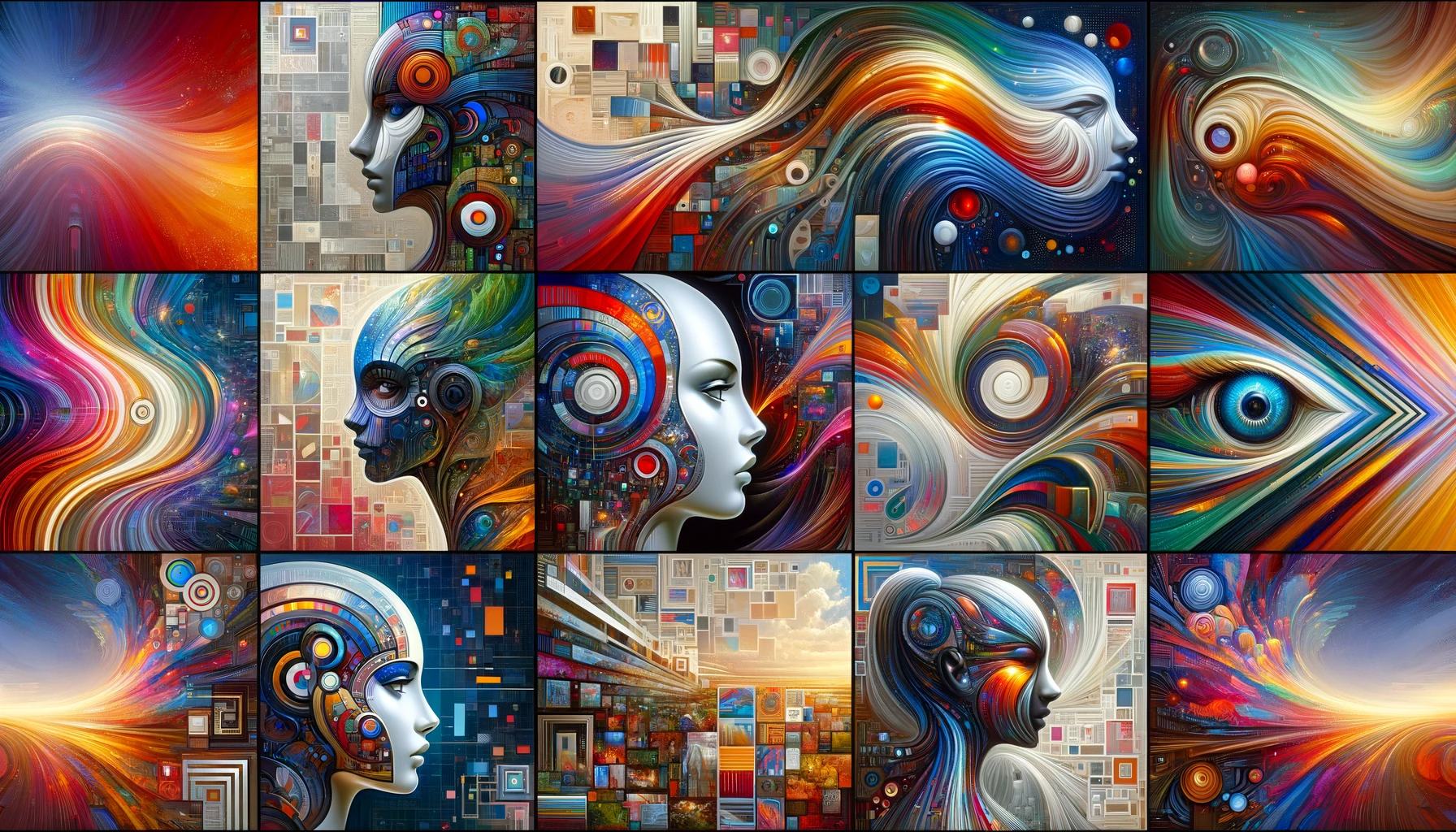List of Art Styles for AI Prompts - 22 Styles with Prompt Tips

Artificial Intelligence (AI) has revolutionized the creative world, providing artists and enthusiasts with powerful AI art generators that can transform simple text prompts into complex visual expressions. Whether drawing inspiration from classical movements or embracing the avant-garde, there are many different styles you can achieve with AI. In this article we are going to go over a list of art styles for AI prompts.
Disclaimer: This article contains affiliate links where we may receive a small commission at no extra cost to you, if you purchase through the link. For more information read my Disclosure.
Types of AI Art Styles

There are many different types of art out there. Here is a list with a description of some AI art styles.
List of AI Art Styles for AI Prompts Descriptions:
1. Realism – Focuses on accurate and detailed representations of subjects, often resembling a photograph.
2. Impressionism – Characterized by small, thin brush strokes and open composition, with an emphasis on light in its changing qualities. Claude Monet is a notable artist in this category.
3. Surrealism – Juxtaposes unexpected elements to invoke surprise and uncover subconscious thoughts. Salvador Dali is famed for this style.
4. Cubism – Presented by objects from various angles, creating abstract and fragmented imagery. Pablo Picasso played a vital role in the development of Cubism.
5. Pop Art – Emerged in the 1950s, employs aspects of mass culture and modern imagery, often in a vibrant, colorful manner. Andy Warhol is one of the leading figures in this movement.
6. Op Art – Short for Optical Art, this style focuses on creating optical illusions through abstract patterns and contrasting colors.
7. Expressionism – Seeks to express the emotional experience rather than physical reality. It is often associated with bold colors and dynamic brushstrokes.
8. Minimalism – Strips down the subject to its necessary elements, often using simple shapes and monochromatic palettes.
9. Fauvism – Uses wild, exaggerated colors and portrays feelings over realistic representations. Henri Matisse is a leading Fauvism artist.
10. Photorealism – Involves creating artwork that resembles high-resolution photographs, often with meticulous detail.
11. Renaissance – Marked by a return to classical sources, balance in composition, and realistic portrayals of the human figure. Leonardo da Vinci and Michelangelo are exemplary Renaissance artists.
12. Art Deco – Known for bold geometric shapes, rich colors, and lavish ornamentation, booming in the 1920s and 30s.
13. Art Nouveau – Features a highly stylistic, flowing design of natural forms and structures, a contrast to the angular Art Deco.
14. Avant-garde – Refers to art that is innovative, pushing the boundaries of what is accepted as the norm or the status quo.
15. Rococo – Signifies a highly ornate and theatrical style of decoration which includes asymmetry, scrolling curves, and pastel colors.
16. Romanticism – Emphasizes strong emotions and individualism with a focus on nature, the past, and the exotic.
17. Anime – A style of animation originating from Japan, featuring colorful artwork with fantastical themes and vibrant characters.
18. Charcoal – A drawing technique using charred sticks of wood, known for its rich blacks and range from sharp lines to soft shading.
19. Street Art – Also known as graffiti art, it is visual art created in public locations and usually features a strong social or political message.
20. Surrealism – Explores the creative potential of the unconscious mind through bizarre and dream-like imagery.
21. Portrait – The artistic representation of a person, where the face and its expression are predominant.
22. Object- In AI art, objects may refer to the focal elements that are depicted, sometimes in unusual or abstract contexts.
Types of AI Art Prompts
Example produced with Leonardo AI with the prompt: “Depict a serene, snow-covered cityscape at dawn, with warm lights glowing from cozy homes amidst a tranquil, wintry setting.”
Digital Art Forms and AI Prompts
Digital Art Forms cover a wide range of styles and aesthetics, which can be harnessed through detailed and thought-out prompts.
Examples of Art Forms and how to craft them with a prompt:
- Drawing: “Create a digital sketch of a beach at sunrise.”
- Illustration: “Design an illustration of a whimsical forest inspired by children’s book aesthetics.”
- Landscape: “Render a landscape illustrating the Sahara Desert in the style of the Romanticism movement.”
- Cityscape: “Depict a serene, snow-covered cityscape at dawn, with warm lights glowing from cozy homes amidst a tranquil, wintry setting.”
- Comic: “Produce a comic strip detailing the adventures of a steampunk inventor.”
- Abstract Expressionism: “Formulate an abstract expressionist rendering using bold, dynamic brush strokes.”
- Pixel Art: “Craft an 8-bit pixel art scene from a retro video game.”
- Collage: “Construct a collage that juxtaposes modern digital culture with classical art elements.”
- Cinematic: “Create a cinematic poster for a science fiction movie set in a dystopian world.”
Each artwork produced by the AI art generator can be unique, reflecting the intricacies of the prompt and the inherent variability of AI interpretation. The ability to combine various elements such as aesthetic, form, and thematic content makes AI prompts a powerful tool in the hands of any designer, artist, or enthusiast.
Sometimes you have to add more detail to your prompts or try different wording combinations to get the design you want.
AI Art Prompt Cheat Sheet Tips:
Crafting effective AI art prompts is essential for generating images that align with your vision. Here are some tips to help you create prompts that yield the best results:
-
Be Specific: Clearly describe the subject, style, and elements you want in your artwork. The more detailed your description, the closer the result will match your expectations. For instance, instead of saying “a cat,” specify “a fluffy Siamese cat with bright blue eyes sitting in a sunlit garden.”
-
Include Art Styles or Movements: Mention specific art styles, techniques, or movements you want to emulate, such as “impressionist,” “surreal,” or “pop art.” This guides the AI to replicate that particular aesthetic in your artwork.
-
Reference Renowned Artists: If you’re inspired by certain artists, include their names in your prompt. For example, “in the style of Van Gogh” can instruct the AI to adopt similar brushwork and color schemes.
-
Mention Medium and Technique: Specify if you want the artwork to look like it’s made with oil paints, watercolors, pencil sketches, or any other medium. This can greatly affect the texture and overall feel of the piece.
-
Define the Mood or Atmosphere: Words like “serene,” “chaotic,” “melancholic,” or “joyful” can help set the emotional tone of the artwork.
-
Use Descriptive Adjectives: Descriptors such as “gleaming,” “decayed,” “ethereal,” or “vibrant” can add depth and character to the subject of your artwork.
-
Consider Composition: If you have a preference for the layout or perspective, like “bird’s eye view” or “close-up,” include this in your prompt to influence the composition of the piece.
-
Experiment and Iterate: Don’t be afraid to refine your prompts through trial and error. Sometimes, small adjustments in wording can lead to significantly different results.
-
Keep it Concise: While details are important, being too verbose can confuse the AI. Strive for a balance between being descriptive and being succinct.
By following these tips, you’ll be better equipped to create prompts that guide AI art generators to produce artwork and designs.
Using the Right AI Art (Graphic Design) Software
Different AI software apps specialize in various art forms, such as portraits, comics, or finely detailed illustrations. Patterns, shapes, and sizes are important considerations that can affect the clarity of an image, helping to avoid unwanted blurry outcomes.
Some of the AI art software that we recommend are: OpenArt, Leonardo, getimg,ai, ArtSmart AI and Limewire.
The choice of application can greatly influence the aesthetic quality of the generated art: some platforms may have strengths in generating vibrant and rich colors, while others may be better at handling subtle lighting effects and shadows. Users should select an app that aligns with the intended style and technical requirements of their project.


